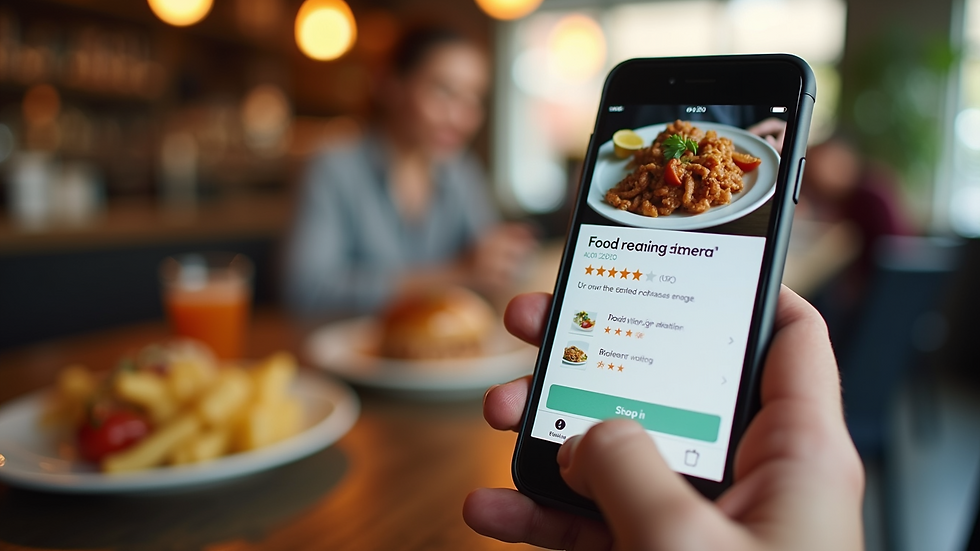Decoding Healthy Eating in 2025: Are Food Labels, Rating Apps, or Journals Most Essential?
- Rick Delarosa

- Jun 18
- 4 min read
As we move into 2025, the conversation around healthy eating is not just growing; it's transforming. People are increasingly aware of the impact food choices have on their overall health. Today, a variety of tools are available to help individuals make informed decisions about their diets. Food labels, food rating apps, and food journals are primary options parents, fitness enthusiasts, and busy professionals utilize. But which of these is the best tool to support a healthy lifestyle? Let’s break down the strengths of each option and find the best choice for you.
The Role of Food Labels
Food labels are foundational in understanding nutrition. They provide key information on serving sizes, calorie counts, and nutritional values. For instance, a can of soup might reveal that it contains 200 calories per serving along with 30% of the daily recommended sodium intake. This kind of information is crucial for consumers wanting to maintain a balanced diet.
In 2025, food labels are becoming even more transparent, often spotlighting healthier options. Research shows that 61% of consumers regularly check nutritional labels to make better choices. However, many still struggle to understand the technical jargon associated with nutrition. For example, terms like "whole grain" versus "multigrain" can be confusing, as only whole grain contributes significantly to fiber intake.
To harness the power of food labels effectively, you need to become familiar with basic nutritional terms. Learning to spot added sugars, trans fats, and sodium content is vital. While food labels are an essential part of healthy eating, they do require some knowledge and practice to use effectively.
The Rise of Food Rating Apps
Food rating apps have surged in popularity for good reason. They allow users to scan barcodes on food packaging and instantly receive ratings based on nutritional quality—making healthy choices simple and fast. For example, the MyFitnessPal app not only tracks calories but also provides personalized food recommendations based on your dietary goals.
By 2025, many apps will include features like dietary logging and community forums where users share tips. Studies show that individuals using these apps report a 25% improvement in their dietary habits within a few months. However, caution is necessary. Not all apps utilize reliable databases, which can lead to incorrect nutrient information. Cross-referencing app data with credible resources is crucial to avoid misinformation.
Accurate food ratings can motivate people to stick to healthier choices, making apps a practical tool in a modern diet. Yet it’s important to remember that they should complement, not replace, other nutritional tools.

The Importance of Food Journals
Food journaling, while traditional, is a powerful way to gain insights into your eating habits. This technique involves recording everything consumed daily, helping you recognize patterns that might contribute to your health goals. For example, someone might find they snack more on weekends or are unaware of their portion sizes.
In 2025, various digital platforms have simplified the process of food journaling. A significant benefit is reflection. Research shows that people who regularly journal about their meals tend to make healthier decisions and are 40% more likely to stay on track with their diet goals. One reason for this is the accountability that comes from tracking what you eat; it often leads to more thoughtful food choices.
Despite its advantages, consistently maintaining a food journal can be challenging. Many find the process tedious, leading to gaps in their entries. Without expert guidance, it’s also easy to misinterpret the data, which can result in poor dietary decisions.

Comparing the Three Approaches
Now that we've explored food labels, rating apps, and food journals, let's compare these methods in a clear, structured manner.
Accessibility: Food labels are always available on packaged foods, while apps need a smartphone for use. Journals can be both physical notebooks or digital documents, giving versatility.
Learning Curve: Food labels often require nutritional knowledge to interpret effectively. Rating apps are user-friendly and simplify the decision-making process. Food journals depend heavily on individual commitment and discipline.
Personalization: Food rating apps and journals can provide tailored advice based on user habits. In contrast, food labels typically offer broad information about the food itself.
Each method has distinct strengths and appeals. Those familiar with technology might find rating apps most useful, while others who appreciate the traditional approach may thrive with journal entries.
Final Thoughts on Your Healthy Eating Journey
As we reflect on food labels, rating apps, and food journals, it becomes clear that each tool plays a vital role in maintaining a healthy diet in 2025. Their effectiveness often hinges on individual preferences and lifestyles. A balanced approach that incorporates all three can yield the best results.
To optimize your healthy eating efforts, utilize food labels to understand ingredient quality, rely on food rating apps for quick decisions on the go, and keep a food journal for personal insights and accountability. By combining these resources, you'll be well on your way to a nourishing and sustainable diet that aligns with your personal health goals.




Comments